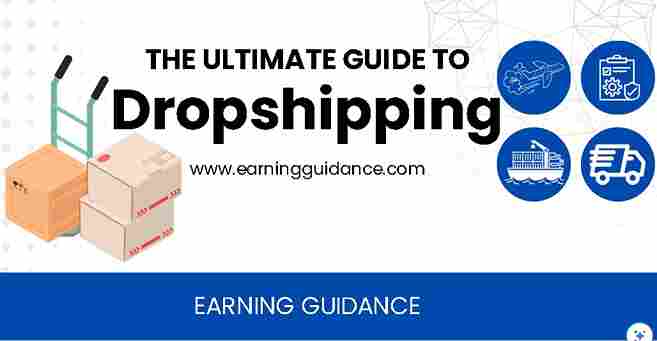Table Of Contents
- 1 Ultimate Guide to Dropshipping
- 1.1 Introduction
- 1.2 Understanding Dropshipping
- 1.3 Setting Up Your Dropshipping Business
- 1.4 Product Sourcing and Research
- 1.5 Building Your Dropshipping Store
- 1.6 Marketing and Promoting Your Dropshipping Business
- 1.7 Managing Orders and Inventory
- 1.8 Customer Service and Retention
- 1.9 Scaling and Growing Your Dropshipping Business
- 1.10 Legal and Financial Considerations
- 1.11 FAQs
- 1.11.1 What are the pros and cons of dropshipping?
- 1.11.2 How do I find reputable suppliers for my dropshipping store?
- 1.11.3 What marketing strategies work best for dropshipping businesses?
- 1.11.4 How can I handle returns and customer refunds in dropshipping?
- 1.11.5 What are some common challenges in dropshipping and how to overcome them?
- 1.12 Conclusion
Ultimate Guide to Dropshipping
Introduction
Dropshipping has emerged as a popular business model in the modern e-commerce landscape. Dropshipping refers to a retail fulfillment method where the store doesn’t keep the products it sells in stock. Instead, when a store sells a product, it purchases the item from a third party and has it shipped directly to the customer. This guide aims to provide a comprehensive understanding of dropshipping and equip aspiring entrepreneurs with the knowledge needed to succeed in this industry.
Harnessing the Power of Social Media to Promote Your Blog
Understanding Dropshipping
Definition and Concept
Dropshipping is a business model that allows entrepreneurs to operate an online store without having to carry inventory. Dropshipping involves partnering with suppliers and wholesalers who handle product storage, packaging, and shipping. As a dropshipper, you focus on marketing and driving sales while the suppliers handle the logistical aspects.
How Dropshipping Works
This process eliminates the need for you to handle inventory or manage the shipping logistics. Here’s a closer look at each step:
- Showcase Products on Your Online Store:
- Select the products you want to sell and display them on your e-commerce website or online marketplace.
- Create attractive product listings with high-quality images, detailed descriptions, and pricing information.
- Customer Places an Order and Makes a Purchase:
- A customer visits your online store, browses through the available products, and selects the items they wish to purchase.
- They proceed to the checkout page, where they provide their shipping address and payment details.
- The customer completes the purchase by confirming the order and making the payment.
- Forward Order Details to the Supplier:
- Once the customer’s order is confirmed and payment is received, you need to forward the order details to the supplier.
- This typically involves sending an email or using an automated system to notify the supplier about the order.
- The order details should include the customer’s shipping address, product details, quantities, and any special instructions.
- Supplier Prepares and Ships the Products:
- Upon receiving the order details, the supplier prepares the products for shipping.
- They package the items, include any necessary branding or marketing materials, and generate shipping labels.
- The supplier then arranges for the shipment of the products directly to the customer’s address.
- They handle all aspects of the fulfillment process, including packaging, labeling, and choosing the appropriate shipping method.
- Customer Receives the Shipment:
- The supplier ships the products to the customer’s address, using the shipping details provided.
- The customer receives the shipment at their doorstep or designated delivery location.
- The packaging may or may not include any indication of the supplier’s involvement, depending on the arrangement and branding preferences.
- Customer Support and After-Sales Service:
- As the store owner, you remain responsible for providing customer support and addressing any post-purchase inquiries or concerns.
- This includes handling questions about order status, returns, refunds, and exchanges.
- You act as the intermediary between the customer and the supplier, ensuring a positive customer experience.
By leveraging the dropshipping model, you can focus on marketing, customer acquisition, and managing your online store, while the suppliers handle the product sourcing, inventory management, and order fulfillment. This allows you to run an e-commerce business with reduced upfront costs and inventory risks.
Differentiating Dropshipping from Other Business Models
When comparing dropshipping to other business models, it’s important to understand the unique advantages it offers. Here are the key differentiating factors:
- Elimination of Upfront Inventory Investment:
- Unlike traditional retail models, dropshipping eliminates the need for you to purchase and store inventory upfront.
- Instead, you rely on your suppliers to fulfill orders directly to your customers, reducing the risk and financial burden of holding inventory.
- Wider Product Selection and Flexibility:
- With dropshipping, you have the flexibility to offer a wide range of products in your online store.
- Since you don’t need to physically stock the items, you can showcase an extensive catalog without worrying about storage space or inventory management constraints.
- This flexibility allows you to test various products and adjust your offerings based on customer demand and market trends.
- Simplified Operations:
- Dropshipping simplifies many operational aspects compared to traditional retail or e-commerce models.
- You are not responsible for tasks such as packaging, labeling, and shipping. The suppliers handle these tasks on your behalf.
- This streamlines your business operations, allowing you to focus more on marketing, customer service, and growing your online store.
- Lower Overhead Costs:
- As a dropshipper, you can significantly reduce your overhead costs compared to brick-and-mortar stores or businesses that require extensive inventory management.
- You don’t need to invest in warehouse space, manage inventory levels, or hire additional staff for order fulfillment.
- This lower cost structure makes dropshipping an attractive option for entrepreneurs and those looking to start an online business with minimal upfront expenses.
- Scalability and Expansion Opportunities:
- Dropshipping offers scalability and growth potential since you are not constrained by inventory limitations or physical store locations.
- You can easily add new products to your store and expand into different niches without incurring additional costs or logistical challenges.
- This scalability allows you to adapt to market trends and quickly adjust your product offerings to meet customer demand.
By understanding these distinctions, you can leverage the unique benefits of dropshipping and tailor your business strategy accordingly.
Setting Up Your Dropshipping Business
To start a successful dropshipping business, certain steps need to be taken:
Choosing a Niche for Your Dropshipping Store
Choosing a profitable and suitable niche is a crucial step in setting up a successful dropshipping store. Here are the key considerations when selecting a niche:
- Passion and Interest:
- Choose a niche that aligns with your interests and passion. This will keep you motivated and engaged in running your business.
- Consider your hobbies, personal preferences, and areas of expertise when selecting a niche.
- Market Demand and Trend Analysis:
- Conduct market research to identify niches with sufficient demand. Look for products that are trending or have a steady demand over time.
- Use keyword research tools, Google Trends, and social media listening to understand the popularity and search volume for potential niche ideas.
- Competition Analysis:
- Assess the level of competition in your chosen niche. High competition can make it challenging to stand out and gain market share.
- Look for niches with moderate competition, where you can differentiate yourself and offer unique value to customers.
- Profitability and Margins:
- Evaluate the profitability of your niche by considering product pricing, profit margins, and potential recurring sales.
- Look for products with a reasonable profit margin that can sustain your business and allow for future growth.
- Target Audience:
- Define your target audience within the niche. Consider factors such as age, gender, location, and interests of your potential customers.
- Understand their needs, preferences, and pain points to curate a product selection and marketing strategy that appeals to them.
- Product Sourcing and Availability:
- Research the availability of products within your niche. Ensure there are reliable suppliers or wholesalers who can fulfill orders consistently.
- Check the quality and reliability of the products to maintain customer satisfaction and build a trustworthy brand.
- Long-Term Viability:
- Consider the long-term viability of your chosen niche. Look for niches that have the potential for sustained growth and aren’t likely to become obsolete quickly.
- Stay updated on industry trends, emerging technologies, and consumer behavior to adapt your business strategy accordingly.
Remember, choosing a niche requires a balance between your interests and market demand. It’s essential to find a sweet spot where your passion meets profitable opportunities. By carefully selecting your niche, you can position your dropshipping store for success in a competitive market.
Finding Reliable Suppliers and Wholesalers
When it comes to dropshipping, finding reliable suppliers and wholesalers is crucial for ensuring smooth operations and customer satisfaction. Here are some steps to help you find trustworthy suppliers for your dropshipping store:
- Online Supplier Directories:
- Utilize online directories such as Alibaba, AliExpress, SaleHoo, or Worldwide Brands to search for suppliers in your niche.
- These directories provide a vast database of suppliers, along with reviews and ratings from other dropshippers.
- Supplier Vetting:
- Thoroughly evaluate each potential supplier before partnering with them.
- Look for suppliers with a positive reputation, good customer reviews, and a track record of timely order fulfillment.
- Check if they offer dropshipping services and if their inventory aligns with your product needs.
- Direct Contact:
- Reach out to potential suppliers directly through email or their contact information provided on their website or directory listing.
- Ask relevant questions to assess their reliability, response time, and willingness to work with dropshippers.
- Samples and Product Quality:
- Request product samples from potential suppliers to evaluate the quality, packaging, and overall customer experience.
- Ensure the products meet your standards and reflect the value you want to offer to your customers.
- Communication and Responsiveness:
- Gauge the supplier’s communication skills and responsiveness during the initial contact.
- Prompt and clear communication is vital for addressing any issues, tracking orders, and ensuring a smooth partnership.
- Order Fulfillment and Shipping:
- Inquire about the supplier’s order fulfillment process and shipping methods.
- Ensure they can handle your expected order volume and provide reliable shipping options that meet your customers’ expectations.
- Terms and Conditions:
- Carefully review the supplier’s terms and conditions, including return policies, payment terms, and any fees associated with dropshipping.
- Ensure their terms align with your business requirements and customer service standards.
- Supplier Reviews and References:
- Look for reviews and testimonials from other dropshippers who have worked with the potential suppliers.
- Reach out to other dropshippers in your niche or online communities to ask for recommendations and insights on reliable suppliers.
Remember, building a solid relationship with your suppliers is essential for long-term success. Regularly assess their performance, maintain open communication, and be proactive in addressing any concerns or issues that may arise. By finding reliable suppliers, you can ensure a consistent supply chain and provide a positive experience for your customers.
Selecting an E-commerce Platform and Setting Up Your Store
Selecting the right e-commerce platform for your dropshipping store is crucial for creating a seamless and user-friendly online shopping experience. Here are the steps to help you choose and set up an e-commerce platform for your dropshipping business:
- Assess Your Needs:
- Determine your specific requirements, including the number of products you plan to sell, customization options, payment gateways, and integrations with dropshipping apps.
- Consider factors such as ease of use, scalability, mobile responsiveness, and SEO capabilities.
- Research E-commerce Platforms:
- Explore popular e-commerce platforms such as Shopify, WooCommerce, BigCommerce, and Magento.
- Read reviews, compare features, pricing plans, and consider the platform’s track record in supporting dropshipping businesses.
- Consider Dropshipping Integration:
- Look for e-commerce platforms that offer seamless integration with dropshipping apps and services.
- Check if the platform has built-in features or plugins/extensions to streamline order management, inventory syncing, and automatic updates.
- Evaluate Design and Customization Options:
- Assess the platform’s design templates and customization capabilities.
- Choose a platform that allows you to create a visually appealing and branded store that aligns with your niche and target audience.
- Payment Gateways:
- Check if the platform supports multiple payment gateways, including popular ones like PayPal, Stripe, or other local payment options.
- Ensure that the payment process is secure and convenient for your customers.
- SEO and Marketing Features:
- Look for built-in SEO tools and marketing features that can help optimize your store for search engines and drive traffic.
- Features like meta tags, URL customization, and integration with marketing tools can enhance your visibility and promotional efforts.
- Mobile Responsiveness:
- In today’s mobile-centric world, choose an e-commerce platform that offers responsive and mobile-friendly themes.
- Mobile optimization is crucial for providing a seamless shopping experience to customers on smartphones and tablets.
- Customer Support:
- Consider the availability and quality of customer support provided by the e-commerce platform.
- Ensure that you have access to reliable technical support to address any issues or challenges that may arise.
Setting Up Your Store:
- Sign up for an Account:
- Create an account on your chosen e-commerce platform by providing the necessary details.
- Choose a Theme:
- Select a theme or template that suits your brand image and store requirements.
- Customize the design elements to align with your branding.
- Configure Store Settings:
- Set up essential store settings, including currency, shipping options, taxes, and language preferences.
- Add Products:
- Use the platform’s product management system to add your dropshipped products.
- Include detailed descriptions, high-quality product images, and relevant information to attract and inform customers.
- Set Up Payment Gateway:
- Configure the payment gateway of your choice to enable secure transactions.
- Ensure that customers can easily make payments using their preferred methods.
- Customize Store Navigation:
- Optimize the store’s navigation and menu structure to enhance user experience and make product discovery seamless.
- Install and Configure Dropshipping Apps:
- Integrate dropshipping apps or plugins that facilitate order management, inventory syncing, and automated updates.
- Configure the settings of the dropshipping app to connect it with your suppliers.
- Test and Launch:
- Before going live, thoroughly test your store to ensure all features, payment gateways, and order processing are functioning correctly.
- Make any necessary adjustments and then launch your dropshipping store.
Remember to regularly update and optimize your store based on customer feedback, market trends, and your business goals. Continuously monitor performance metrics, implement SEO strategies, and refine your store to enhance the shopping experience and drive conversions.
Neil Patel’s Ultimate Guide to Conversion Rate Optimization
Product Sourcing and Research
To ensure a successful dropshipping venture, it’s important to conduct thorough product research and sourcing:
Conducting Market Research and Identifying Trending Products
Before launching your dropshipping store, it’s essential to conduct thorough market research and identify trending products that have the potential to generate sales and attract customers. Here’s a step-by-step guide to help you with this process:
- Define Your Target Market:
- Determine the specific audience you want to target with your dropshipping store.
- Consider factors such as demographics, interests, geographic location, and purchasing power.
- Research Market Trends:
- Stay updated on the latest market trends and consumer preferences.
- Monitor industry news, blogs, social media, and online forums related to your niche.
- Identify emerging trends, popular products, and customer demands.
- Analyze Competitor Stores:
- Study your competitors’ dropshipping stores within your niche.
- Analyze their product offerings, pricing strategies, customer reviews, and overall branding.
- Identify gaps in the market or opportunities to differentiate your store.
- Use Keyword Research:
- Conduct keyword research to identify relevant search terms related to your niche and products.
- Utilize tools like Google Keyword Planner, SEMrush, or Ahrefs to discover popular keywords and search volume.
- Focus on long-tail keywords that indicate specific customer needs or product variations.
- Explore Online Marketplaces and Social Media:
- Visit popular e-commerce platforms and marketplaces like Amazon, eBay, and Etsy.
- Look for best-selling products, customer reviews, and product ratings.
- Monitor social media platforms to identify products that are generating buzz and engagement.
- Use Dropshipping Supplier Directories:
- Explore dropshipping supplier directories such as Oberlo, SaleHoo, or AliExpress.
- Browse through product categories and supplier listings to find potential products.
- Consider suppliers with positive ratings, reliable shipping times, and good customer feedback.
- Analyze Product Demand and Competition:
- Evaluate the demand and competition for potential products.
- Look for products with a balance of sufficient demand and manageable competition.
- Check if the product has consistent search volume, social media engagement, and positive customer reviews.
- Consider Product Profitability:
- Calculate the profitability of potential products by considering factors such as product cost, shipping fees, and market demand.
- Evaluate the potential profit margin and ensure it aligns with your business goals.
- Test Products:
- Before committing to a large inventory, consider testing products with smaller quantities.
- Place sample orders to assess product quality, shipping times, and supplier reliability.
- Monitor customer feedback and adjust your product selection based on their preferences.
- Stay Agile and Adapt:
- Continuously monitor market trends and customer preferences.
- Be willing to adapt and update your product offerings based on changes in demand and competition.
- Regularly evaluate and optimize your product selection to maximize sales potential.
Remember, conducting market research and identifying trending products is an ongoing process. Stay informed, be responsive to customer needs, and regularly update your product offerings to stay ahead in the competitive dropshipping landscape.
Evaluating Product Demand and Competition
When it comes to dropshipping, evaluating product demand and competition is crucial to the success of your business. Here are some steps to help you assess the demand for a product and evaluate the level of competition:
- Analyze Keyword Search Volume:
- Use keyword research tools like Google Keyword Planner, SEMrush, or Ahrefs to identify the search volume for keywords related to your product.
- Higher search volume indicates a higher potential demand for the product.
- Monitor Trends and Seasonality:
- Consider if the demand for the product is consistent throughout the year or if it is subject to seasonal fluctuations.
- Identify any upcoming trends or events that might affect the product’s demand.
- Research Product Reviews and Ratings:
- Look for customer reviews and ratings on e-commerce platforms, marketplaces, and social media.
- Positive reviews and high ratings indicate a satisfied customer base and potential demand.
- Assess Competitor Products:
- Study your competitors’ product offerings within your niche.
- Analyze their pricing, product features, and customer reviews.
- Identify any gaps or areas where you can differentiate your product from the competition.
- Check Social Media Engagement:
- Monitor social media platforms, industry-specific forums, and online communities to gauge the level of interest and engagement around the product.
- Look for posts, comments, and discussions related to the product.
- High engagement indicates potential demand and interest.
- Use Google Trends:
- Utilize Google Trends to understand the popularity and search interest for your product over time.
- Compare the search trends of different products to identify which ones have consistent or growing demand.
- Consider Market Saturation:
- Evaluate the level of competition in the market for your chosen product.
- Look for the number of existing sellers, the quality of their offerings, and their market share.
- A highly saturated market may indicate increased competition and challenges in standing out.
- Test the Product:
- Consider ordering a sample of the product to assess its quality, packaging, and shipping time.
- Test the product yourself to ensure it meets your standards and expectations.
- This allows you to provide accurate product descriptions and firsthand experience to your customers.
Remember that evaluating product demand and competition is an ongoing process. Continuously monitor market trends, adapt to changes, and refine your product selection to meet the evolving needs of your target audience.
Finding Profitable Products to Sell in Your Dropshipping Store
Finding profitable products to sell in your dropshipping store is essential for the success and profitability of your business. Here are some strategies to help you identify and source profitable products:
- Research Niche Markets:
- Explore niche markets that align with your interests, knowledge, and target audience.
- Look for untapped or emerging niches that have the potential for growth and profitability.
- Follow Market Trends:
- Stay updated with the latest industry trends and consumer preferences.
- Monitor popular products, emerging trends, and changing customer demands.
- Utilize trend forecasting tools, industry reports, and social media platforms to identify potential products.
- Analyze Product Popularity:
- Use e-commerce platforms, marketplaces, and social media to identify products with high demand.
- Look for products with consistently high sales and positive customer reviews.
- Consider using tools like Jungle Scout or Helium 10 to analyze product sales data and estimate potential profitability.
- Consider Product Differentiation:
- Look for products that offer unique features, improvements, or customization options.
- Differentiating your products can help you stand out from competitors and attract customers.
- Assess Profit Margins:
- Calculate the potential profit margins for each product by considering the cost of goods, shipping fees, and other expenses.
- Aim for products that offer a reasonable profit margin to ensure sustainability and profitability.
- Evaluate Supplier Reliability:
- Research and vet potential suppliers to ensure they can consistently provide high-quality products and reliable shipping.
- Look for suppliers with positive reviews, good communication, and fast order processing.
- Test Products:
- Consider ordering samples of potential products to evaluate their quality, packaging, and shipping times.
- Test the products yourself to assess their usability and customer satisfaction.
- Use Data Analysis Tools:
- Leverage data analysis tools like Google Analytics, Facebook Insights, or e-commerce platform analytics to identify top-performing products.
- Analyze sales data, customer behavior, and conversion rates to identify profitable products and make data-driven decisions.
Remember to continuously monitor and adapt your product selection based on market trends, customer feedback, and sales performance. Regularly introduce new products and phase out underperforming ones to keep your dropshipping store fresh and profitable.
Building Your Dropshipping Store
A well-designed and user-friendly dropshipping store is crucial for attracting customers and driving sales:
Designing an Appealing and User-Friendly Website
Designing an appealing and user-friendly website is crucial for the success of your dropshipping store. A well-designed website not only attracts visitors but also enhances their browsing experience and encourages conversions. Here are some key considerations for designing your dropshipping website:
- Clean and Intuitive Layout:
- Use a clean and organized layout that is visually appealing and easy to navigate.
- Ensure that important elements such as the logo, menu, search bar, and shopping cart are prominently displayed.
- Consistent Branding:
- Create a cohesive brand identity by using consistent colors, fonts, and imagery throughout your website.
- Incorporate your brand logo and tagline in a prominent position to enhance brand recognition.
- Clear and Engaging Product Displays:
- Use high-quality product images that showcase your products from different angles.
- Provide detailed product descriptions, including specifications, features, and benefits.
- Implement zoom functionality or image galleries to allow users to examine products closely.
- Easy Navigation:
- Design a clear and intuitive navigation menu that allows users to easily find the desired product categories and pages.
- Include a search bar to facilitate quick product searches.
- Mobile Responsiveness:
- Optimize your website for mobile devices to ensure a seamless experience for users on smartphones and tablets.
- Use a responsive design that adapts to different screen sizes and resolutions.
- Fast Page Load Times:
- Optimize your website’s performance to ensure fast page load times.
- Compress images, minify code, and utilize caching techniques to improve website speed.
- User-Friendly Shopping Cart and Checkout Process:
- Make the shopping cart easily accessible and visible from any page.
- Simplify the checkout process by minimizing the number of steps and asking for only essential information.
- Offer guest checkout options to streamline the process for first-time customers.
- Trust Signals and Social Proof:
- Display trust signals such as security badges, customer testimonials, and reviews to build trust and credibility.
- Highlight any awards, certifications, or affiliations that establish your store’s reliability.
- Clear Call-to-Action Buttons:
- Use visually appealing and prominent call-to-action buttons to guide users towards desired actions, such as “Add to Cart” or “Buy Now.”
- Ensure that the buttons stand out from other page elements and are easily clickable.
- Integration with Social Media:
- Include social media buttons or links to encourage visitors to connect with your brand on social platforms.
- Display social media feeds or user-generated content to showcase social proof and engage with your audience.
Remember to regularly test and optimize your website design based on user feedback and analytics data. Continuously improve the user experience to maximize conversions and drive sales on your dropshipping store.
Optimizing Product Pages and Implementing Effective Copywriting
Optimizing your product pages and implementing effective copywriting techniques are essential for driving conversions and maximizing sales on your dropshipping store. Here are some key strategies to optimize your product pages:
- Compelling Product Titles:
- Create descriptive and attention-grabbing product titles that highlight the key features and benefits.
- Incorporate relevant keywords to improve search engine visibility.
- High-Quality Product Images:
- Use high-resolution images that showcase your products from different angles.
- Ensure images are properly sized and optimized for fast loading.
- Include multiple images to provide a comprehensive view of the product.
- Detailed Product Descriptions:
- Write clear, concise, and informative descriptions that accurately depict the product.
- Highlight the key features, specifications, and unique selling points.
- Use bullet points or subheadings to break down information for easy reading.
- Persuasive Product Copy:
- Use persuasive language to create a sense of desire and urgency.
- Highlight the benefits and solutions the product offers to potential customers.
- Address common pain points and explain how the product solves them.
- Clear Pricing and Offers:
- Clearly display the product price, any discounts, and special offers.
- Include information about shipping costs and delivery timeframes.
- Customer Reviews and Testimonials:
- Incorporate customer reviews and testimonials to provide social proof and build trust.
- Showcase positive feedback and ratings to reassure potential customers.
- Clear Call-to-Action:
- Use a prominent and visually appealing call-to-action button, such as “Add to Cart” or “Buy Now.”
- Ensure that the button stands out from other elements on the page.
- Consider using scarcity or urgency techniques, such as limited-time offers or countdown timers, to encourage immediate action.
- Related Products and Cross-Selling:
- Include suggestions for related products or complementary items to encourage upselling and cross-selling.
- Display recommendations based on the customer’s browsing history or similar customer preferences.
- Product Variations and Options:
- If applicable, provide options for different product variations, such as size, color, or quantity.
- Use dropdown menus or selection boxes to make it easy for customers to choose their preferred options.
- Clear Return and Refund Policy:
- Display your return and refund policy clearly to instill confidence in customers.
- Provide information on how to initiate returns or request refunds.
Remember to continuously monitor and analyze the performance of your product pages. Use A/B testing to experiment with different elements, layouts, and copywriting techniques to optimize conversions and improve the user experience.
Enhancing the customer experience with smooth navigation and checkout processes is crucial for maximizing conversions and ensuring a positive shopping experience on your dropshipping store. Here are some key strategies to achieve this:
- Clear and Intuitive Navigation:
- Design a well-organized and easy-to-navigate website structure.
- Use clear and descriptive menu labels for easy navigation.
- Include a search bar to allow users to quickly find specific products.
- Streamlined Product Categories and Filters:
- Group products into relevant categories and subcategories.
- Implement filters to allow users to refine their search based on specific criteria (e.g., price range, size, color).
- Responsive and Mobile-Friendly Design:
- Optimize your website for mobile devices to ensure a seamless browsing experience for users on smartphones and tablets.
- Use responsive design techniques to adapt your website layout and content to different screen sizes.
- Fast Page Load Times:
- Optimize your website’s loading speed to minimize waiting times.
- Compress images, minify code, and leverage caching techniques to improve performance.
- Clear and Visible Add-to-Cart Button:
- Place the add-to-cart button prominently on product pages.
- Ensure the button stands out and is easily clickable.
- Simplified Checkout Process:
- Implement a one-page or minimal-step checkout process.
- Include progress indicators to show users their current step in the checkout process.
- Offer guest checkout options to minimize barriers to purchase.
- Multiple Payment Options:
- Provide a variety of payment options, such as credit/debit cards, PayPal, or digital wallets, to cater to different customer preferences.
- Secure and Trustworthy Payment Gateway:
- Use reputable and secure payment gateways to ensure the safety of customer payment information.
- Display security badges or trust seals to build trust and reassure customers.
- Clear Shipping Information:
- Clearly communicate shipping options, costs, and estimated delivery times.
- Offer options for express shipping or order tracking, if possible.
- Personalization and Account Features:
- Allow customers to create accounts to save their preferences, order history, and shipping addresses.
- Provide personalized recommendations based on their browsing and purchase history.
- Order Confirmation and Communication:
- Send immediate order confirmation emails to customers after successful purchases.
- Provide clear communication throughout the fulfillment process, including shipping updates and tracking information.
- Easy Returns and Refunds:
- Clearly communicate your return and refund policy to customers.
- Streamline the process for initiating returns and requesting refunds.
By implementing these strategies, you can create a seamless and user-friendly experience for your customers, ultimately increasing customer satisfaction, loyalty, and conversions on your dropshipping store.
Marketing and Promoting Your Dropshipping Business
Effectively marketing your dropshipping business is crucial for generating traffic and driving sales:
Developing a Comprehensive Marketing Strategy
Developing a comprehensive marketing strategy for your dropshipping business is crucial to drive traffic, generate sales, and build brand awareness. Here are key steps to consider when developing your strategy:
- Define Your Target Audience:
- Identify your ideal customer demographics, interests, and pain points.
- Conduct market research to understand their needs and preferences.
- Create buyer personas to guide your marketing efforts.
- Set Clear Marketing Goals:
- Define specific, measurable, achievable, relevant, and time-bound (SMART) goals.
- Examples: increase website traffic by X%, generate X number of sales per month, grow social media followers by X%.
- Conduct Competitor Analysis:
- Identify your main competitors in the dropshipping industry.
- Analyze their marketing strategies, products, pricing, and customer engagement.
- Identify gaps and opportunities to differentiate your business.
- Build Your Brand Identity:
- Develop a unique and compelling brand identity that resonates with your target audience.
- Create a memorable brand name, logo, and tagline.
- Define your brand voice, values, and key messaging.
- Content Marketing:
- Create valuable and engaging content related to your niche and products.
- Publish blog posts, videos, tutorials, guides, and infographics.
- Share content on your website, blog, and social media channels.
- Optimize content for search engines with relevant keywords.
- Social Media Marketing:
- Identify the social media platforms your target audience uses.
- Establish a presence on those platforms and create compelling profiles.
- Share engaging and relevant content, including product showcases, promotions, and industry news.
- Encourage user-generated content and engage with your audience through comments, messages, and shares.
- Influencer Marketing:
- Identify influencers relevant to your niche and target audience.
- Collaborate with influencers to promote your products through sponsored posts, reviews, or giveaways.
- Leverage their reach and credibility to expand your brand’s visibility.
- Email Marketing:
- Build an email list by offering incentives such as discounts or exclusive content.
- Send regular newsletters, product updates, and personalized offers.
- Use automation to nurture leads, recover abandoned carts, and re-engage customers.
- Search Engine Optimization (SEO):
- Optimize your website and product pages for relevant keywords.
- Improve website loading speed, user experience, and mobile-friendliness.
- Build high-quality backlinks and citations from reputable websites.
- Paid Advertising:
- Consider paid advertising channels such as Google Ads, Facebook Ads, or Instagram Ads.
- Set a budget and target specific keywords, demographics, or interests.
- Monitor and optimize your campaigns based on performance metrics.
- Analyze and Track Results:
- Use analytics tools to track and measure the effectiveness of your marketing efforts.
- Monitor website traffic, conversion rates, sales, and engagement metrics.
- Adjust your strategies based on data-driven insights.
Remember to continuously evaluate and adapt your marketing strategy based on market trends, customer feedback, and performance indicators. By implementing a comprehensive marketing strategy, you can effectively promote your dropshipping business and drive its success.
Utilizing Social Media and Content Marketing
Utilizing social media and content marketing is essential for promoting your dropshipping business and engaging with your target audience. Here are some key strategies to consider:
- Choose Relevant Social Media Platforms:
- Identify the social media platforms that your target audience frequents.
- Focus on platforms such as Facebook, Instagram, Pinterest, Twitter, or LinkedIn, depending on your niche and target demographic.
- Create Compelling Profiles:
- Optimize your social media profiles with your brand logo, description, and website link.
- Maintain a consistent brand identity across all social media channels.
- Develop a Content Strategy:
- Create a content calendar to plan and organize your social media content.
- Include a mix of promotional content, educational content, user-generated content, and industry news.
- Engage with Your Audience:
- Respond to comments, messages, and mentions promptly and professionally.
- Encourage user-generated content by running contests, giveaways, or using branded hashtags.
- Share Product Showcases and Tutorials:
- Highlight your products through visually appealing images, videos, or GIFs.
- Create tutorials or “how-to” guides that demonstrate the use or benefits of your products.
- Leverage Influencer Partnerships:
- Collaborate with influencers in your niche to promote your products to their followers.
- Choose influencers who align with your brand values and have an engaged and relevant audience.
- Use Paid Advertising on Social Media:
- Consider using social media advertising platforms such as Facebook Ads or Instagram Ads to reach a broader audience.
- Define your target audience, set a budget, and create compelling ad campaigns.
- Share Blog Posts and Articles:
- Create informative and valuable blog posts related to your products or niche.
- Share these articles on your social media channels to drive traffic to your website and establish yourself as an authority in your industry.
- Engage in Community Building:
- Participate in relevant social media groups or forums where your target audience congregates.
- Share insights, answer questions, and contribute valuable information to establish your expertise and build relationships.
- Monitor and Analyze Performance:
- Use social media analytics tools to track the performance of your social media posts, engagement metrics, and follower growth.
- Identify the types of content that resonate most with your audience and adjust your strategy accordingly.
Remember to keep your social media content engaging, authentic, and aligned with your brand identity. Consistency, interaction, and valuable content are key to successfully utilizing social media and content marketing for your dropshipping business.
Hootsuite’s Complete Guide to Social Media Advertising
Implementing Paid Advertising Campaigns for Targeted Reach
Implementing paid advertising campaigns can significantly boost the reach and visibility of your dropshipping business. Here are some key steps to consider when running paid advertising campaigns:
- Define Your Advertising Goals:
- Determine the specific goals you want to achieve through paid advertising, such as increasing website traffic, generating leads, or driving sales.
- Identify Your Target Audience:
- Clearly define your target audience based on demographics, interests, and behaviors.
- Use this information to create detailed customer personas that will guide your advertising efforts.
- Choose the Right Advertising Platforms:
- Select the advertising platforms that align with your target audience and business goals.
- Popular platforms for paid advertising include Google Ads, Facebook Ads, Instagram Ads, LinkedIn Ads, and Pinterest Ads.
- Set a Budget:
- Determine how much you are willing to spend on advertising campaigns.
- Start with a conservative budget and gradually increase it as you see positive results.
- Create Compelling Advertisements:
- Develop attention-grabbing headlines, engaging ad copy, and appealing visuals.
- Highlight the unique selling points of your products and use persuasive language to entice your audience.
- Select Ad Formats:
- Choose the appropriate ad formats based on the platform you are using.
- Options may include text ads, image ads, video ads, carousel ads, or interactive ads.
- Utilize Targeting Options:
- Leverage the targeting options available on each platform to reach your specific audience.
- Refine your targeting based on demographics, location, interests, and previous online behavior.
- Optimize Landing Pages:
- Ensure that the landing pages your ads lead to are relevant, well-designed, and optimized for conversions.
- Use clear and concise calls-to-action to guide visitors towards desired actions, such as making a purchase or signing up for a newsletter.
- Monitor and Analyze Performance:
- Regularly monitor the performance of your paid advertising campaigns.
- Track key metrics such as click-through rates, conversion rates, cost per click, and return on ad spend.
- Make data-driven decisions and optimize your campaigns based on the insights gained.
- A/B Testing and Iteration:
- Experiment with different variations of your ads, including different headlines, visuals, or ad formats.
- Perform A/B testing to identify which elements drive the best results.
- Continuously refine and optimize your campaigns to maximize their effectiveness.
By implementing paid advertising campaigns, you can reach a larger audience, drive targeted traffic to your dropshipping store, and increase the chances of conversions and sales.
Shopify’s Ultimate Guide to Paid Advertising
Managing Orders and Inventory
Efficiently handling orders and inventory is crucial for a successful dropshipping operation:
Processing Orders and Managing Customer Expectations
Have a streamlined system in place to process orders promptly. Communicate with your suppliers to ensure timely fulfillment and keep customers informed about their order status. Provide excellent customer service to manage their expectations.
Tracking Inventory and Handling Stock Management
Monitor your inventory levels and keep track of stock availability. Coordinate with your suppliers to ensure stock replenishment and prevent selling out-of-stock products. Implement inventory management tools to automate this process.
Dealing with Shipping and Fulfillment Processes
Establish clear shipping and fulfillment processes with your suppliers. Communicate shipping methods, estimated delivery times, and any specific requirements to ensure smooth order fulfillment.
Customer Service and Retention
Building strong customer relationships and fostering loyalty is essential for long-term success:
Providing Excellent Customer Support
Offer prompt and helpful customer support through various channels, such as email, live chat, or phone. Address customer inquiries, concerns, and issues in a timely and professional manner.
Implementing Effective Communication Channels
Utilize email marketing and automated notifications to keep customers informed about new products, promotions, and order updates. Nurture customer relationships through personalized and targeted communication.
Strategies for Building Customer Loyalty and Encouraging Repeat Purchases
Implement customer retention strategies such as loyalty programs, discounts, and personalized recommendations. Provide incentives for customers to return to your store and build a loyal customer base.
Scaling and Growing Your Dropshipping Business
Once your dropshipping business is established, focus on expanding and scaling your operations:
Expanding Product Offerings and Diversifying Your Store
Continuously research and add new products to your store to meet customer demands and stay ahead of trends. Explore related niches and expand your product offerings to cater to a wider audience.
Leveraging Data and Analytics for Business Optimization
Monitor key performance metrics and analyze data to gain insights into customer behavior, product performance, and marketing effectiveness. Utilize this data to optimize your store, marketing campaigns, and overall business strategy.
Exploring New Markets and Sales Channels
Consider expanding into new markets or exploring additional sales channels, such as selling on different online marketplaces or partnering with influencers or affiliates. Evaluate opportunities for growth and diversification.
Legal and Financial Considerations
Ensure compliance with legal and financial obligations to protect your business:
Understanding Legal Obligations and Regulations
Familiarize yourself with relevant laws and regulations related to dropshipping, such as consumer protection laws, privacy regulations, and product safety standards. Comply with legal requirements to avoid any legal issues.
Managing Finances and Tracking Expenses
Establish a sound financial system to manage your business finances effectively. Keep track of your expenses, revenues, and profit margins. Utilize accounting software or tools to streamline financial management.
Establishing a Strong Business Foundation
Consider formalizing your dropshipping business by registering it as a legal entity. Consult with legal and financial professionals to ensure your business structure and processes are in compliance with regulations.
FAQs
What are the pros and cons of dropshipping?
- Pros:
- Low startup costs and minimal financial risk.
- No need to handle inventory or shipping logistics.
- Flexibility to work from anywhere with an internet connection.
- Cons:
- Lower profit margins compared to traditional retail models.
- Dependency on suppliers for product availability and quality.
- Potential for increased customer inquiries and support demands.
How do I find reputable suppliers for my dropshipping store?
Research and vet potential suppliers by considering factors such as product quality, reliability, and customer reviews. Attend trade shows, reach out to manufacturers directly, or use dropshipping directories to find reputable suppliers.
What marketing strategies work best for dropshipping businesses?
A combination of social media marketing, content marketing, search engine optimization (SEO), and paid advertising can be effective for promoting dropshipping businesses. Tailor your marketing strategies to your target audience and product niche.
How can I handle returns and customer refunds in dropshipping?
Establish clear return and refund policies and communicate them to your customers. Coordinate with your suppliers to handle returns and ensure timely refunds or replacements. Provide excellent customer service throughout the process.
What are some common challenges in dropshipping and how to overcome them?
- Common challenges include:
- Intense competition and price pressure.
- Managing inventory and avoiding stockouts.
- Building customer trust and credibility.
- Strategies to overcome these challenges:
- Differentiate your store through unique products or branding.
- Implement effective inventory management systems.
- Provide exceptional customer service and build strong relationships.
Conclusion
In conclusion, dropshipping offers a promising business opportunity for aspiring entrepreneurs in the e-commerce industry. By understanding the key aspects of dropshipping, setting up a robust store, implementing effective marketing strategies, and prioritizing customer satisfaction, you can pave the way for a successful and profitable dropshipping business. Take action, follow the steps outlined in this guide, and embark on your dropshipping journey today.













3 thoughts on “The Ultimate Guide to Dropshipping: Everything You Need to Know”